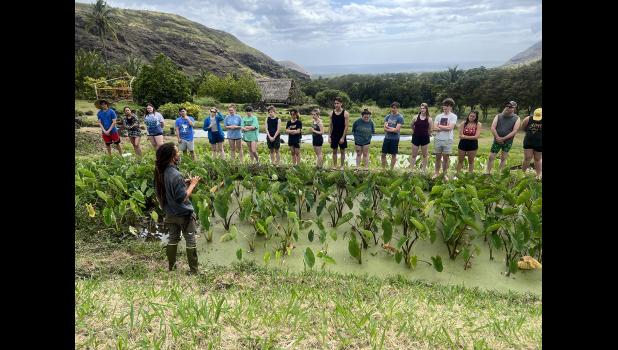Nome-Beltz students travel to Hawaii for cultural exchange
Sixteen Nome-Beltz students – 14 seniors and two juniors – traveled to Hawaii last month to learn the ways in which their counterparts on Oahu live and perpetuate their Native culture. The exchange is part of a three-year program called TASK, Teacher Ambassadors Sharing Knowledge, that already saw Nome teachers and educators from Wai’anae on Oahu visit each other with the goal to collaborate on culturally informed STEM (short for science, technology, engineering and mathematics) teachings. Nome-Beltz Principal Jay Thomas explained that the purpose of the TASK program is to bring cultural relevance to the curriculum and highlighting both the Native Alaskan and Native Hawaiian similarities of two Native cultures, struggling to maintain cultural identity despite Western colonization.
In October of 2019, 22 teachers from Wai’anea and Nanakuli came to Nome. Then, in 2020 the COVID-19 pandemic hit and crossed plans for exchange visits happening in 2020 or 2021. During spring break this year, 16 teachers from Nome Public Schools went to O’ahu. From April 10-16, 16 students from Nome, plus three chaperones, made the trip to the island to experience the efforts of cultural and language revitalization undertaken by the Wai’anea High School and Nanakuli Middle School, among other things.
The Nome students were eased into the Polynesian culture with an entertaining “crash course” at the Polynesian Cultural Center, a luau and an evening show aiming to educate tourists to the culture, customs, song and dance of Polynesia. The following days, the Nome students became visitors when the itinerary took them off the beaten tourist path into the community of Wai’anea and Nanakuli on the west side of O’ahu and to the north shore. “The reason we chose Nanakuli and Wai’anae is that the communities have the highest population of Native Hawaiians [on Oahu] and it’s an area that is like Nome, and socioeconomically challenged,” explained Principal Thomas. “We were looking for schools that had same struggles.” Before entering the Wai’ainae school, or any other place the students went to, they were greeted with an ‘ole kahea, a welcome chant, and upon leaving, the Hawaiian hosts would release them with another farewell chant. The Wai’anae students introduced the Nome kids to their Searider Productions program – complete with a screen-print shop where they produce Searider and Wai’anae school logo wear, as well as labs of three-D printing and a photo studio where students learn photography and even produce news casts. Their cultural program includes a seaweed and shrimp operation, planting and studying the uses of Native plants. The effort in Wai’anae was a decade in the making, when years ago, gangs wreaked havoc in the poor neighborhood and dedicated teachers knew they had to offer their students a meaningful alternative from a life of drug and alcohol abuse. Cultural revitalization and language immersion is now the result of those early efforts and student hosts showing the Nome kids around knew their stuff: not only did they confidently sing Hawaiian chants, but their everyday life was punctuated with Hawaiian knowledge of plants, Hula Mingling with their Hawaiian peers, in the warm trade wind breeze laden with the smell of plumeria flowers, the Nome students described their cold, ice-bound world of subsistence hunting, fishing and NYO sports to their new Hawaiian friends. The students went on to experience a remarkable revival of a kalo farm, deep in the Wai’anea valley and learned about the ancient way of land division and caring for the land – malama ‘aina — and family, in the old Hawaiian way.
On the North Shore, the students visited fish ponds that are modeled after the ancient way of utilizing tides to fill brackish ponds to give mullet fish a good start in life. A channel needed to be dug between the ocean shore and the ponds, so the Nome-Beltz students were enlisted to help and they got the deed done in less than an hour.
“We relied on our Hawaiian partners to be visitors not tourists,” said Thomas.
The grant that allowed the exchange was written by K-12 Outreach Director Glenda Findlay at the University of Alaska Fairbanks. Findlay and Thomas collaborated on the grant. Thomas said the purpose was to look at science and the western way of STEM education and make it relevant to students whose heritage includes Indigenous knowledge. The program aimed at exposing the students to make that cultural connection between science and the “Native ways of knowing” be it in agriculture as exemplified in the kalo patch or the seaweed and shrimp operation.
In fall, if the pandemic allows, the Hawaiian students are slated to come to Nome and visit the region. Thomas said the plan is to write a continuation grant to maintain the exchange between the Alaskan and Hawaiian cultures. “We really just kicked the door open, there is so much more to be done,” he said.

